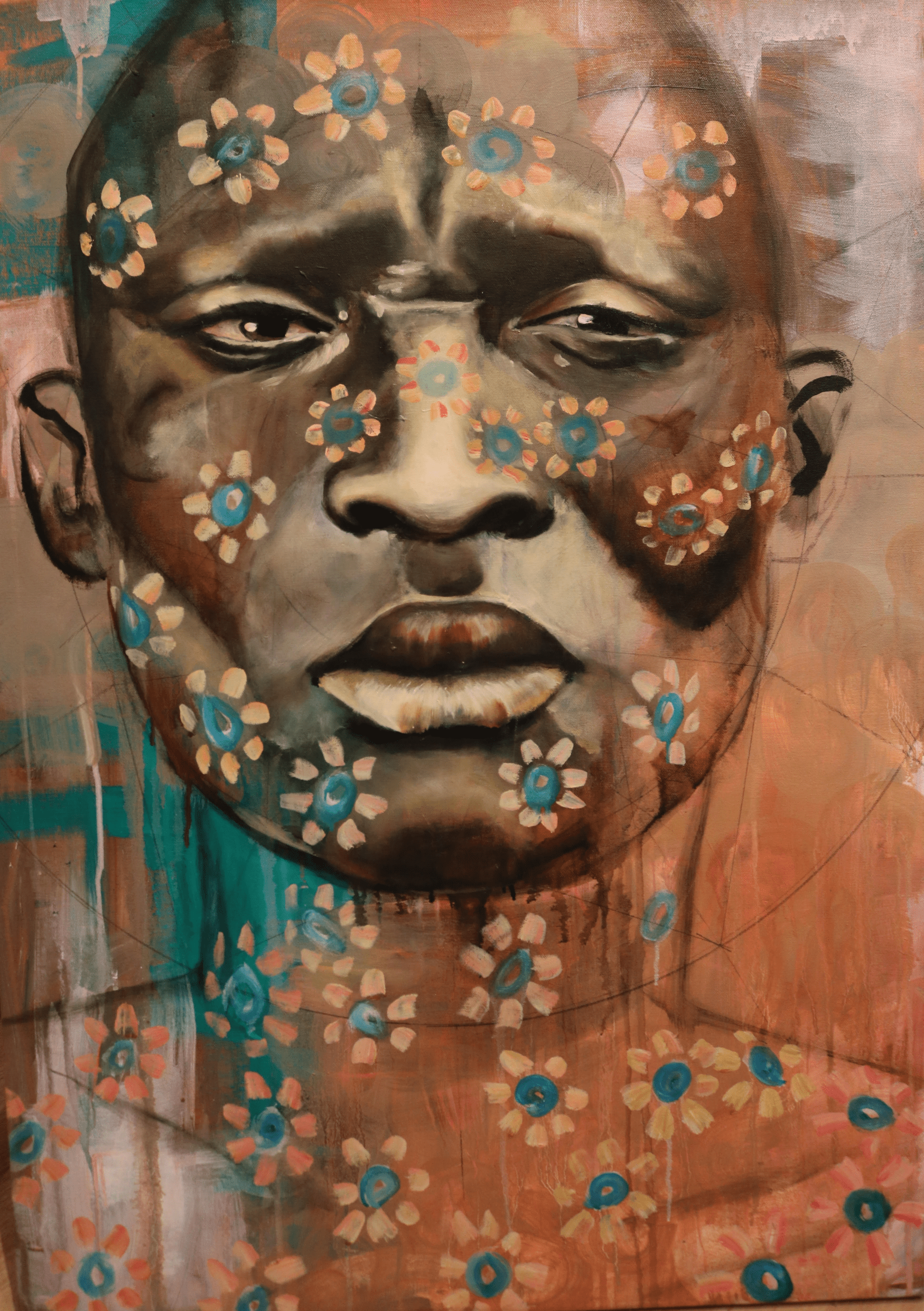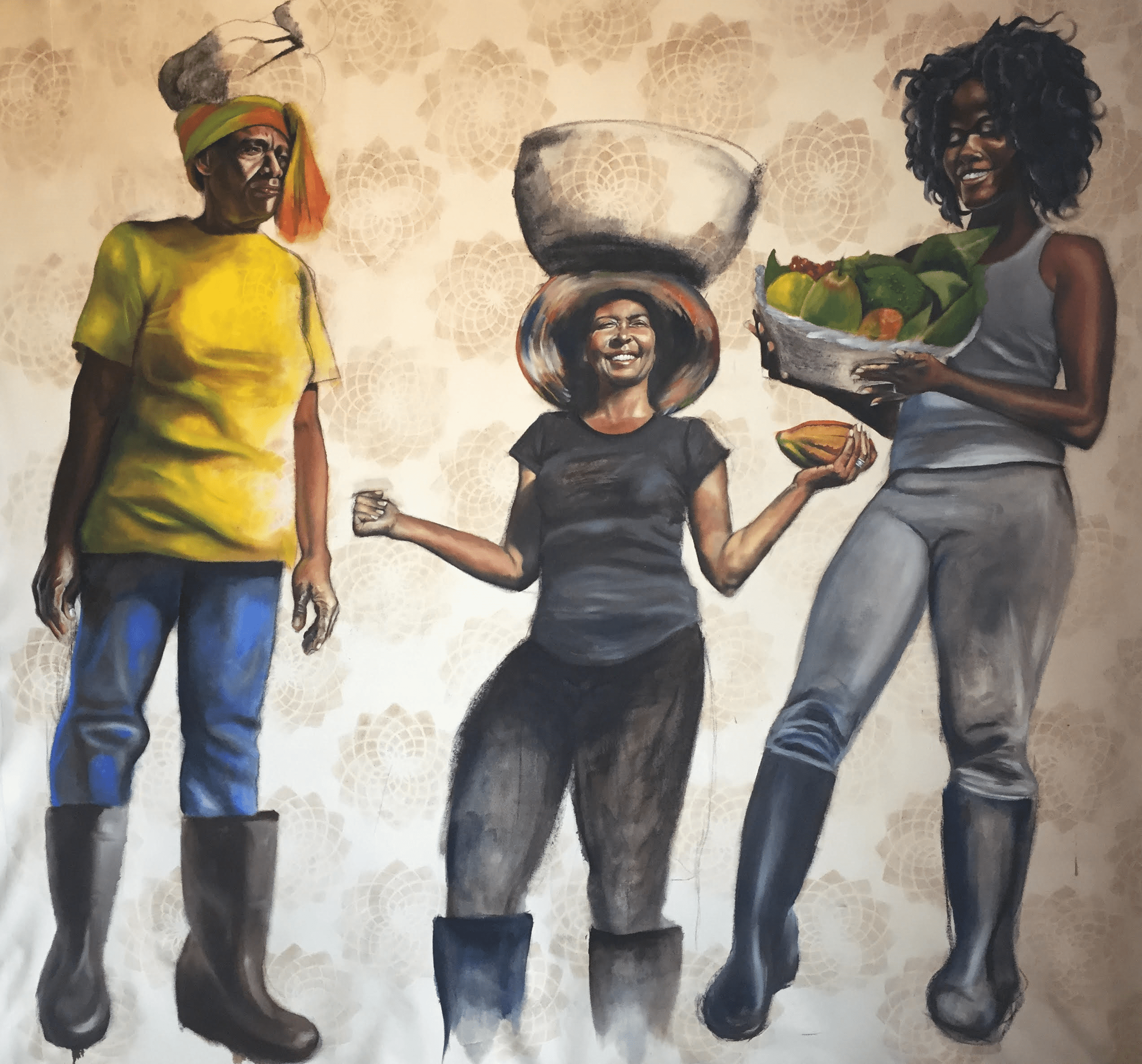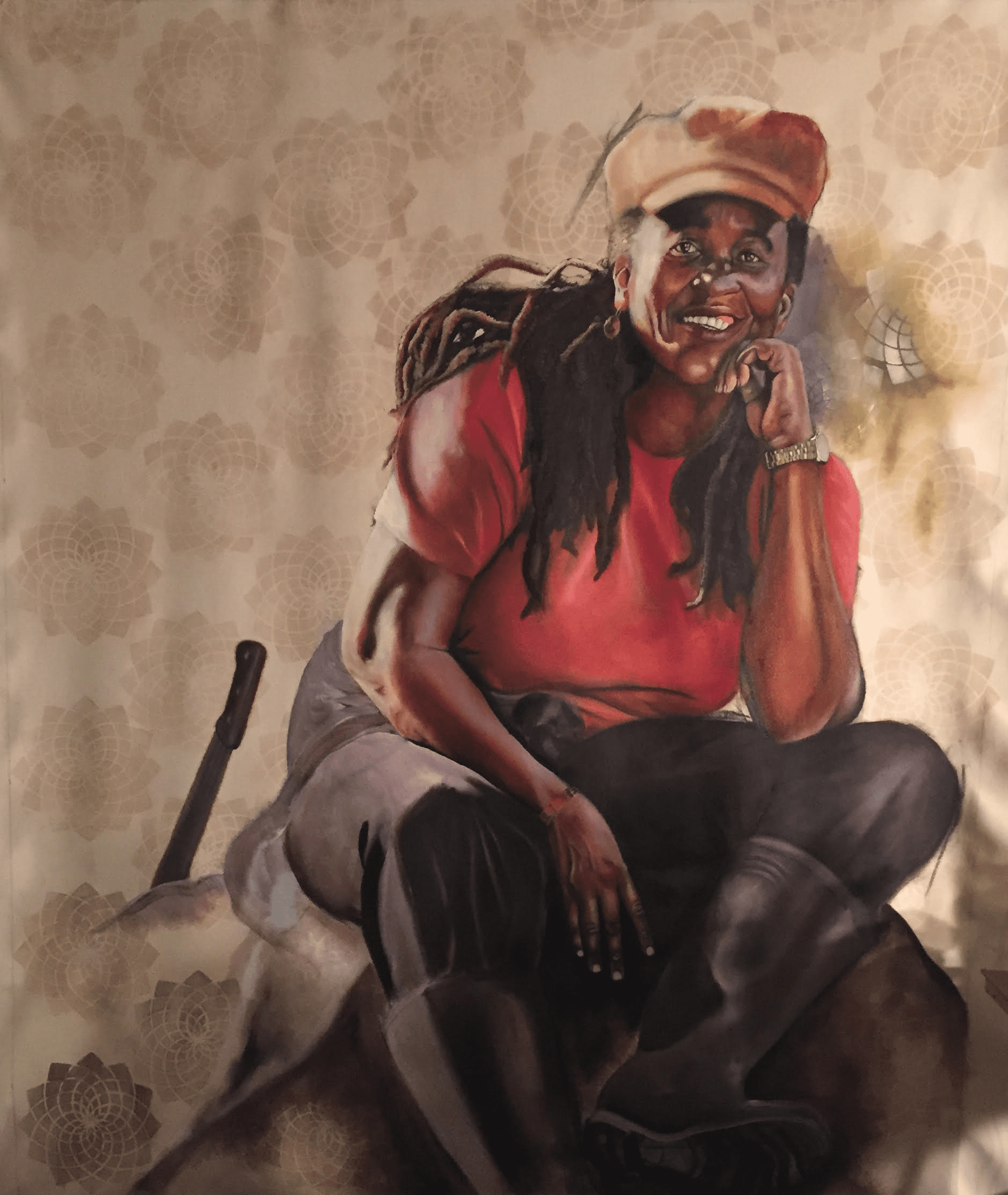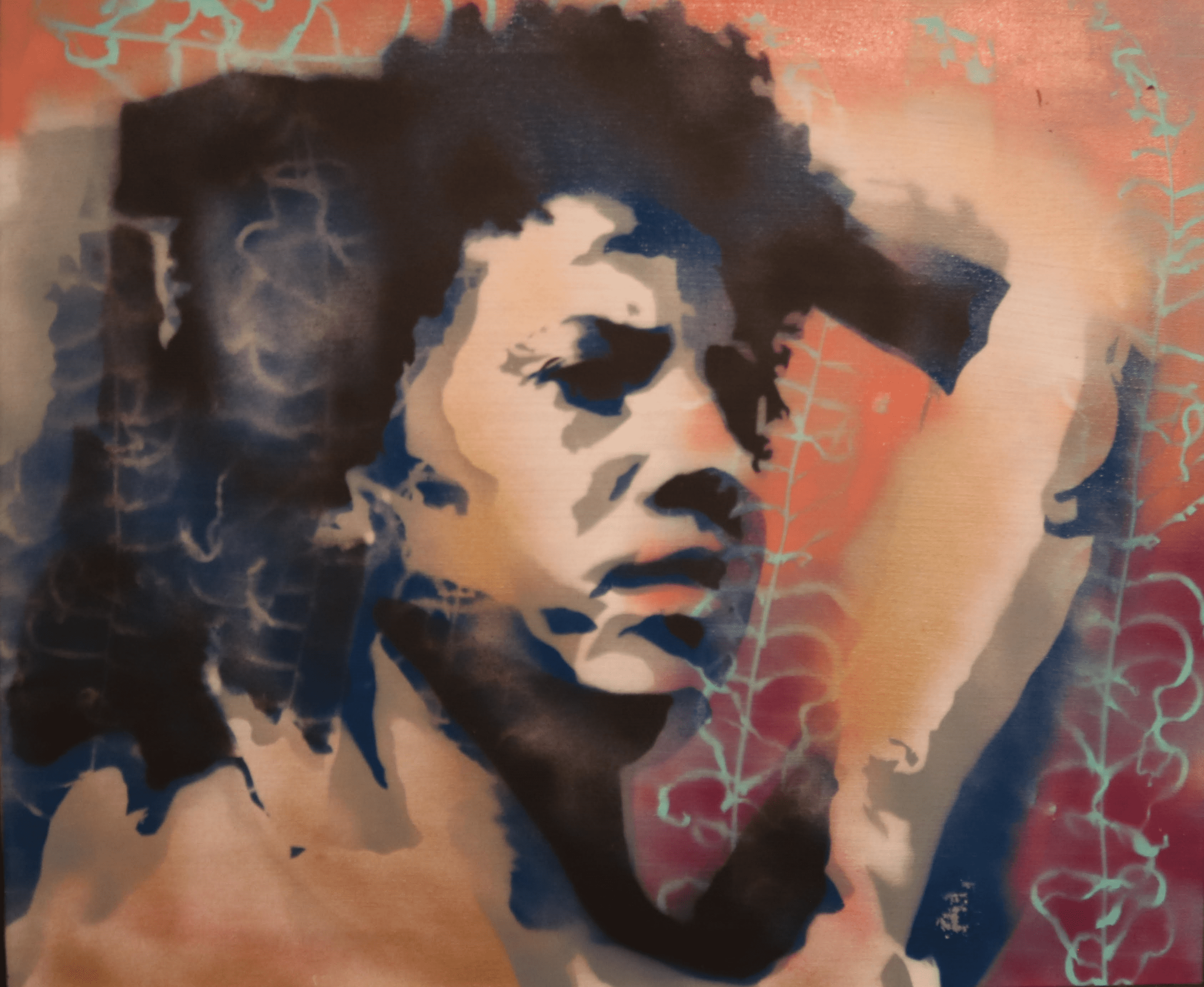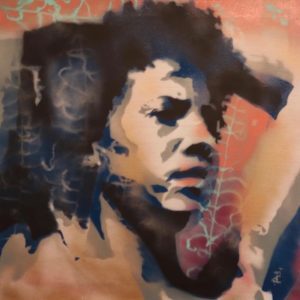
When I think of Grenada, I think of steaming mugs of cocoa tea. Notice, I didn’t say hot chocolate. I’m not talking about a drink made with processed, powdered stuff you buy in cans. I’m talking about a drink coming to the table straight from this island’s rich volcanic soil. I’m talking about gnarled black hands, knuckles swollen, grating a ball of raw chocolate, then cracking nutmeg, then splintering a piece of cinnamon bark, then boiling it all together. The whole house engulfed in spicy, earthy aromas. I’m talking about lifting that mug to your nose and seeing the fat of the land, the cocoa oils, floating above the milk. Sip it, taste the blackness and opulence that has borne these crops—spice and cocoa—for centuries. There is nothing more Creole.
And then here comes this white boy, Asher Mains. Red-haired too, and bearded, like the pirates that once rummaged Grenada’s coves.
What draws me into the Mains’s art gallery in Grand Anse is a painting leaning against the leg of a desk. An androgynous black face covered in bluish flowers. Full lips, wide flatish nose, high cheekbones, luminescent skin—all familiar. But it’s the eyes and the frown, the expression of painful disappointment, set on that regal face and surrounded by flowers.
As I approach, my eyes skid away to the left, enticed by three giant women. They stand in their floor-to-ceiling canvas wearing work clothes: t-shirts, long pants, and rubber boots. Two balance loads on their heads, one holds a basket of fruit. One is sullen, two are grinning. The mirth on their faces is so real I find myself smiling back at them.
What are they? Three black muses? Patronesses of agriculture? I turn to the man seated at the desk, only on the periphery of my awareness till now, to ask about these paintings.
“Hi,” I say, but then there’s an awkward pause as I notice the huge portrait on the wall directly behind him. A dreadlocked lady leaning playfully to the side, propping her chin. She also wears work clothes; a cutlass is stuck into the ground at her side. She is beaming, mischievously. In my mind I name her “Cutlass-Tanty,” and it seems obvious that she was painted by the same artist as the female triumvirate.
The similarity is in the faces. A palpable dignity and confidence in each one, self-possession—even the flower-covered man (I’ve decided it’s a man). This artist’s work evokes a uniquely Caribbean adjective: “conscious” or, as black Americans would say, “woke.” But not in an angry, fight the power way. No, in a majestic is who I am way. I sense that these people are being portrayed exactly as they are and would wish to be seen by the world. Not as victims or pawns in a centuries-old drama, but as proud Grenadians.
Finally, I ask the seated, long-sleeve-shirted white man, “These are fascinating. Is this a local Grenadian artist? Who is it?”
He gets up from behind the desk and says with a shy smile, “Actually these are mine.”
“As in: you own them?”
”No, I’m the artist.”
I was not expecting that. These weren’t Caribbean landscapes—the type of art I most closely associate with local white artists—and there’d been nothing in the portraits to suggest the work was that of “The Other.” Nothing flippant. No exaggeration of physical features. No attempt to exoticize. Nor anglicize—to paint “black” women who are basically white girls dipped in chocolate. I couldn’t detect even a vestige of guilt or discomfort in the brushstrokes, nothing to indicate a white hand wrestling with the dark side of race relations in the Caribbean.
I temper my surprise and ask Grenadian artist, Asher Mains, about his inspiration.
He tells me about the Cocoa Farmers Project, which he completed during his MFA in Creative Practice. He painted portraits of real, ordinary Grenadian cocoa farmers. Some portraits, like the large pieces I’d been admiring, had been displayed in the Mains Gallery and shown internationally. But there were others, smaller portraits, which he gave to the farmers themselves as gifts, to display on the walls of their homes.
The idea, he explains, was to give agriculture the recognition and pride of place it deserves, but has been getting less and less of, in modern Grenadian society. Grenada farms some of the finest cocoa, and yet the younger generations—the farmers’ children themselves—hold that livelihood in low esteem. Portraits should not only be done of famous and wealthy people, Asher believes, because it does something to see yourself rendered in art. He is passionate about that “something.” He tells me of the grandchildren of Cutlass-Tanty coming into the gallery, being so excited to see their granny up on the wall, and their elation when they looked at the tag and realized their granny was worth so much. It does something.
A customer enters the gallery, so I release Asher and stroll along to another section, mulling things over. I can’t be the only one who’s been startled by his work, who senses the dangerous undercurrents he’s waded into. A white man capturing images of black farmers, in a land built on the agronomics of forced plantation labor. A white man making money by selling black people. It hasn’t been two hundred years since slavery ended in the British West Indies—the wound is still too fresh. But maybe Asher doesn’t feel accused or constrained by that history. He’s only second-generation Grenadian—his grandparents emigrated from America in the 1950s.
A new grappe of faces, dark blue and stenciled, draw my attention. Four separately framed but identical profiles of an afro-wearing woman. The background of each is a different color but they lack the lushness, the blended pigments of the cocoa-farmer pieces. These are more edgy and monochromatic, like what you might print with an inky stamp-pad. And yet, I suspect they are also Asher’s work. On the other hand, I’m debating whether the elegant defiance I see in this Nubian profile could possibly originate from him.
He returns and confirms that the blue faces are his doing. I nod and make attentive noises while he talks about his stencil-making process, but I’m considering if the fault is mine for being surprised by Asher’s work. Maybe I’ve watched too much TV lately and gotten jaded by the most powerful white man in the world referring to “The Blacks” as if they were a species unconnected to whites. Maybe that’s why Asher’s artistic intimacy seems so anachronistic and refreshing at this moment.
I ask him outright, “Have you taken any flack for painting black people?”
Yes, he has. One lady, a conflict resolution specialist, told him all she sees in his art is racial conflict. Others, commenting on the Cocoa Farmers Project, have accused him of being the prototypical white exploiter. He confides that when he first started doing portraiture, he used only three colors—red, yellow and purple—so that he wouldn’t have to deal with the dynamics of being a white renderer of black skin. With time, though, Asher has grown bold. He trusts his motives and paints whomever he wants, with the understanding that people will always view his work through the prism of their own prejudices.
“And your motive is?” I ask.
Asher explains that the Cocoa Farmers Project involved real dialogue and exchange with the farmers and their families. He learned about them; they learned about art. He realized that for those Grenadians, even if they were interested in pursuing art, the materials were too esoteric and unavailable. The paints, charcoal, brushes all came from abroad and were prohibitively expensive. Art was a rich man’s pursuit, not a cocoa farmer’s. Asher became passionate about making and sourcing art materials exclusively within Grenada.
He runs over to the other side of the gallery and returns with a jar of crooked black sticks—drawing charcoal which he’s made from the stems of a quick-growing local plant. Then he ushers me to two other stenciled pieces, these emitting a sepia, historical tone like old photographs. “Here I experimented with making my own pigments,” he says, “using vinegar, pomegranate leaves, and rust.” Looking closer at the canvas, I can actually see little pomegranate leaves embedded. Then Asher points to the four afro-lady stencils and explains that, in each case, a different plant had been overlaid. “Just leaves of plants I have around the house,” he says. We go back to Cutlass-Tanty, my favorite, and Asher shows me the brown geometric pattern in the background. “I made that with cocoa tea,” he says.
The tour de force comes when he tells me about his current project, Sea Lungs, which will be on display at the Grenada National Pavilion of the Venice Biennale 2017. Grenadian sea fans (underwater vegetation) are backlit casting a shadow onto the portraits, evoking the bronchial effect of lungs. The sea is life to island people.
I get what Asher is saying. I understand his passion for authenticity—that the subject, matter, and materials of his art should reference each other. But there’s something more at work within him. Asher Mains is no pirate, no white plunderer of blackness. He is a Grenadian: born in America, yes, but here in Grenada from birth; he grew up here, he lives here still. He seeks, in his art, to give expression to and enter into deeper relationship with that Grenadian identity. To fill it out, to explore the connectedness between this place and everything that flourishes naturally here, including its people. In that sense, Asher Mains creates self-portraits.
***
Images © Asher Maines. Photographs used with permission of the artist.

